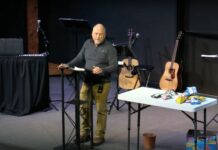It is possible Indigenous peoples gave their handiworks to Catholic missionaries for the 1925 expo or that the missionaries bought them. But historians question whether the items could have been offered freely given the power imbalances at play in Catholic missions and the government’s policy of eliminating Indigenous traditions, which Canada’s Truth and Reconciliation Commission has called “cultural genocide.”
“By the power structure of what was going on at that time, it would be very hard for me to accept that there wasn’t some coercion going on in those communities to get these objects,” said Michael Galban, a Washoe and Mono Lake Paiute who is director and curator of the Seneca Art & Culture Center in upstate New York.
Gloria Bell, a fellow at the American Academy in Rome and assistant professor in McGill University’s department of art history and communication studies, agreed.
“Using the term ‘gift’ just covers up the whole history,” said Bell, who is of Metis ancestry and is completing a book about the 1925 expo. “We really need to question the context of how these cultural belongings got to the Vatican, and then also their relation to Indigenous communities today.”
Katsitsionni Fox, a Mohawk filmmaker who served as spiritual adviser to the spring First Nations delegation, said she saw items that belong to her people and need to be “rematriated,” or brought back home to the motherland.
“You can sense that that’s not where they belong and that’s not where they want to be,” she said of the wampum belts, war clubs and other items she documented with her phone camera.
The Inuit delegation, meanwhile, inquired about an Inuit kayak in the collection.
The Vatican Museums declined repeated requests for an interview or comment.
Opening the revamped Anima Mundi gallery space in 2019 with artifacts from Oceania as well as a temporary Amazon exhibit, Francis said the items were cared for “with the same passion reserved for the masterpieces of the Renaissance or the immortal Greek and Roman statues.”
You might miss the Anima Mundi if you were to spend the day in the Vatican Museums. Official tours don’t include it and the audio guide, which features descriptions of two dozen museums and galleries, ignores it entirely. Private guides say they rarely take visitors there because there is no explanatory signage on display cases or wall text panels.
Margo Neale, who helped curate the Vatican’s 2010 Aboriginal exhibition at the Anima Mundi as head of the Centre for Indigenous Knowledges at the Australian National Museum, said it is unacceptable for Indigenous collections today to lack informational labels.
“They are not being given the respect they deserve by being named in any way,” said Neale, a member of the Kulin and Gumbaingirr nations. “They are beautifully displayed but are culturally diminished by the lack of acknowledgement of anything other than their ‘exotic otherness.’”
In Victoria, British Columbia, Gregory Scofield has amassed a community collection of about 100 items of Metis beadwork, embroidery and other workmanship that he tracked down and acquired via online auctions and through travel and made available to Metis scholars and artists.
Scofield, a Metis poet and author of the forthcoming book “Our Grandmother’s Hands: Repatriating Metis Material Art,” said any discussion with the Vatican should focus on granting Indigenous scholars full access to the collection and, ultimately, bringing items home.
“These pieces hold our stories,” he said. “These pieces hold our history. These pieces hold the energy of those ancestral grandmothers.”
___
Associated Press religion coverage receives support through the AP’s collaboration with The Conversation US, with funding from Lilly Endowment Inc. The AP is solely responsible for this content.
This article originally appeared on APNews.com.











